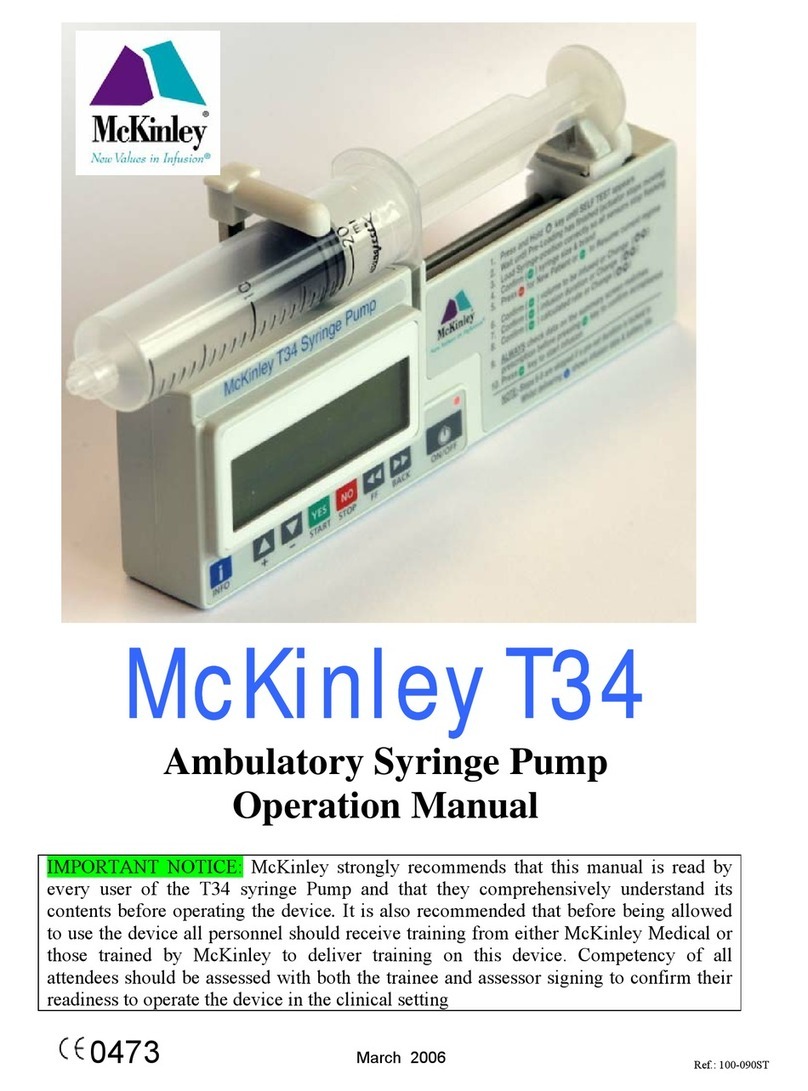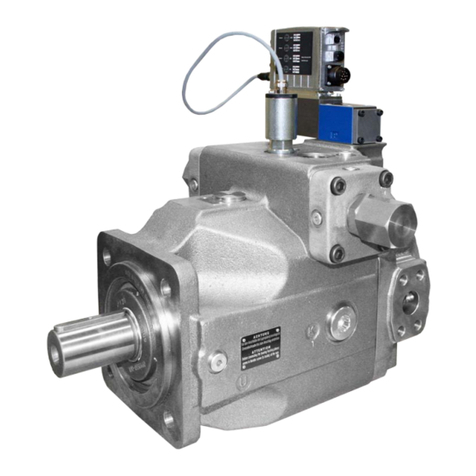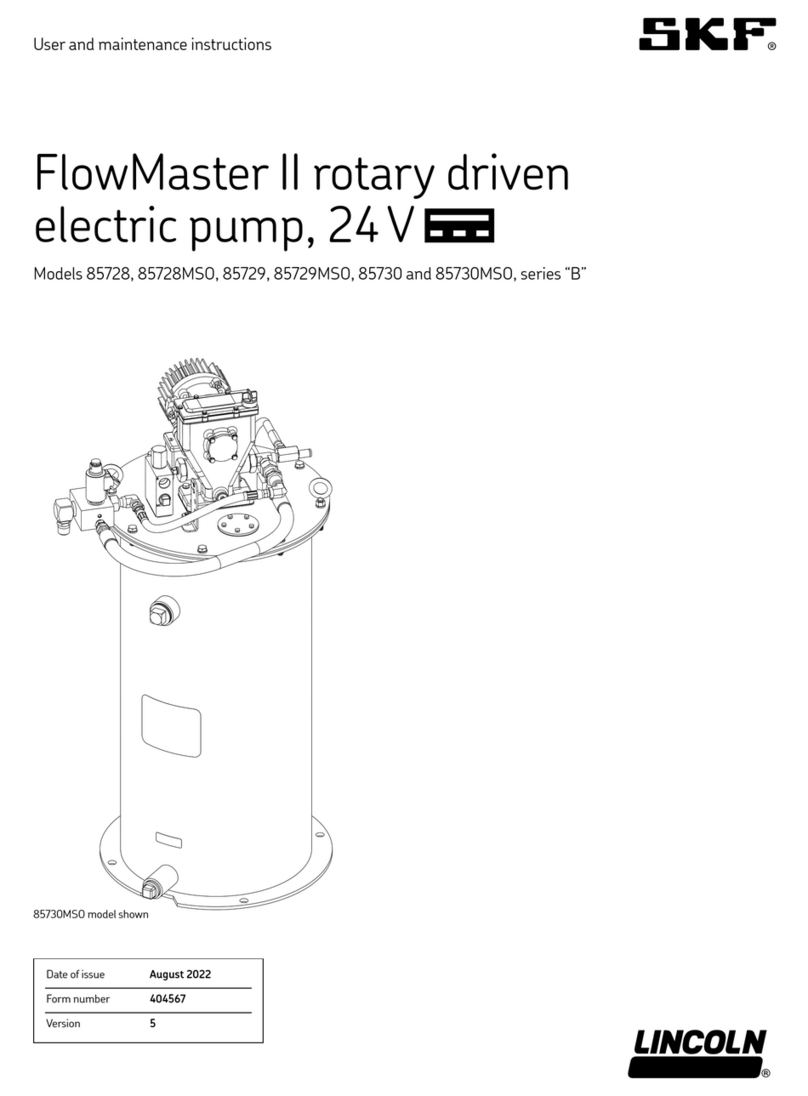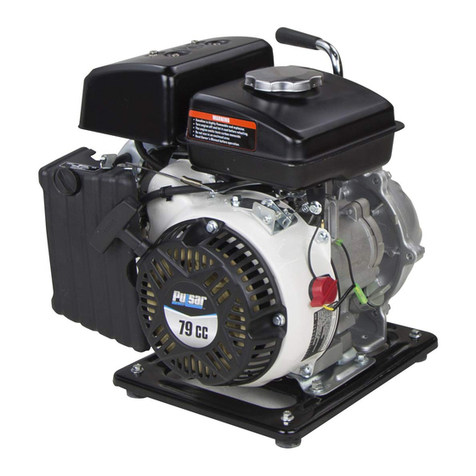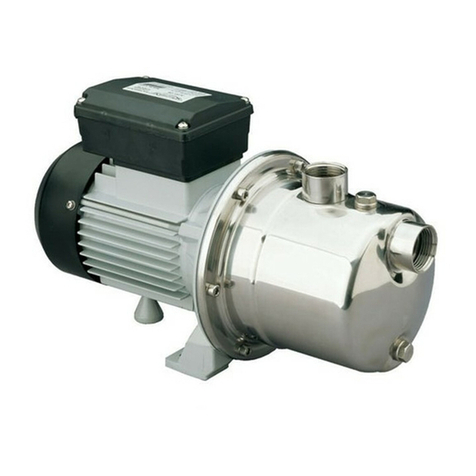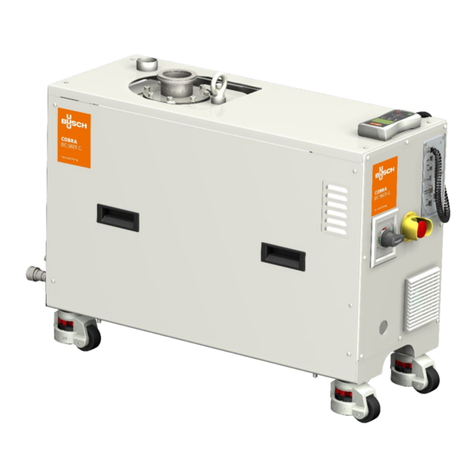NMFIRE NFPA20 Instruction manual


We reserve the right to change the information without prior notice!
Contents
1.0 GENERAL ..........................................................................................................................................1
1.1 Safety Instruction...........................................................................................................................................1
1.2 Safety Symbols...............................................................................................................................................1
1.3 Safety Precaution...........................................................................................................................................2
1.4 Safety Instruction for Operator/User......................................................................................................6
1.4.1 Moving parts may cause serious injury..........................................................................................7
1.4.2 Electric Shocks and Arc Flashes may cause serious injury.......................................................7
1.4.3 Shut Down the Faulty Fire Pump Group........................................................................................8
1.4.4 AC Power Supply and Isolation ........................................................................................................9
1.4.5 Disconnect AC power ..........................................................................................................................9
1.4.6 Low Voltage Equipment (36 V to 500 KV) ....................................................................................9
1.4.7 Inflammable of Fuel Oil and Aerosol............................................................................................10
1.4.8 Overflow.................................................................................................................................................10
1.4.9 Liquid Storage Unit.............................................................................................................................10
1.4.10 Do not operate in combustible or explosive environments...............................................10
1.4.11 Hazard of Emission...........................................................................................................................11
1.4.12 Exhaust Precautions .........................................................................................................................11
1.4.13 Shutdown and Disassembly ..........................................................................................................12
2.0 TRANSPORTATION AND HANDLING .....................................................................................12
2.1 Lifting...............................................................................................................................................................12
2.1.1 Containerized Fire Pump Group Lifting-ISO 3874:1997........................................................13
2.1.2 Electric Fire Pump Group Lifting ....................................................................................................13
2.1.3 Diesel Engine Fire Pump Group Lifting........................................................................................14
3.0 INSTALLATION..............................................................................................................................14
3.1 On-site Installation .....................................................................................................................................15
3.1.1 Location..................................................................................................................................................15
3.1.2 Foundation ............................................................................................................................................15
3.1.3 Fire Pump Group Placement ...........................................................................................................15
3.2 Fixing and concreting.................................................................................................................................15
3.2.1 Base Foundation..................................................................................................................................16
3.2.2 Anchor Bolt and Sizing Block ..........................................................................................................16
3.2.3 Concreting .............................................................................................................................................17
3.3 Suction Pipeline of Fire Pump.................................................................................................................17
3.3.1 Pump Suction Pipeline for ESF and SCF......................................................................................17
3.3.2 Pump Suction Pipeline for VTP.......................................................................................................23
3.4 Discharge Pipe of Fire Pump Line..........................................................................................................24
3.4.1 Discharge pipe of the motor fire pump.......................................................................................24
3.4.2 Discharge pipe of the diesel fire pump .......................................................................................24
3.5 Diesel Engine Cooling Water Discharge..............................................................................................25
3.6 Diesel Exhaust System Fixed Installation .............................................................................................26
3.7 Fuel Tank Installation..................................................................................................................................28
3.8 Flow Meter Installation ..............................................................................................................................29

We reserve the right to change the information without prior notice!
3.9 Fire Pump Controller Pressure Sensing Line......................................................................................30
3.10 Fire Pump Controller Wire and Cable Connection........................................................................32
3.10.1 Jockey Pump Controller..................................................................................................................32
3.10.2 Electric Motor Fire Pump Controller...........................................................................................33
3.10.3 Diesel Engine Fire Pump Controller............................................................................................33
3.10.4 Diesel Engine Battery Cable Connection ..................................................................................35
4.0 INSTALLATION AND COMMISSIONING ................................................................................36
4.1 Jockey Pump.................................................................................................................................................36
4.1.1 Jockey Pump Start Requirements..................................................................................................37
4.1.2 Pressure Tank (if install).....................................................................................................................39
4.2 Electric Motor Fire Pump..........................................................................................................................41
4.2.1 Install check before starting.............................................................................................................42
4.2.2 Start Running........................................................................................................................................44
4.3 Diesel Engine Fire Pump ...........................................................................................................................46
4.3.1 Install check before starting.............................................................................................................47
4.3.2 Start Running........................................................................................................................................52
5.0 FIRE PUMP SYSTEM CONTROL LOGIC....................................................................................52
6.0 TROUBLE SHOOTING..................................................................................................................53
6.1 Electric motor pump...................................................................................................................................53
6.2 Diesel engine ................................................................................................................................................55

-1-
1.0 GENERAL
This manual is included in the documentation package attached to the specific fire pump set
provided by CNP NM FIRE. If this manual is provided to you separately, please contact with
CNP NM FIRE or your supplier.
Note
The operator is duty-bound to read and understand all warnings and precautions in the
documentation regarding the operation and routine maintenance of the fire pump
equipment.
1.1 Safety Instruction
This manual contains instructions to be followed when installing and maintaining the fire
pump group.
Equipment must be properly operated and maintained to ensure safe and efficient operation.
Many accidents are caused by failure to follow basic rules and precautions.
1.2 Safety Symbols
Danger
This signal word indicates there is a possible danger to the operator or equipment.
Warning
This signal word indicates a high-risk hazard which, if not avoided, will result in death
or serious injury.
Caution
This signal word indicates a medium-risk hazard which, if not avoided, will result
in death or serious injury.
Note
This signal word indicates where the information is important, but there is a danger.

-2-
1.3 Safety Precaution
Warning
Pressurized Coolant
1. High temperature coolant may cause serious burns.
2. Do not open the radiator or heat-exchanger pressure cover while the diesel engine is
under running/ high temperature.
3. Cool down the engine prior to removing the coolant pressure cap.
4. Turn the pressure cap slowly and do not open it completely until the pressure is
released.
Warning
Moving parts
1. Moving parts may result in death or serious injury.
2. Make sure all the protect guard are in the correct position, before starting the fire
pump group.
Warning
Poisonous
1. Waste oil has been identified by health agencies around the world as a cause of cancer
or productive system poisoning.
2. Do not ingest, inhale fumes or contact with the waste oil whiling checking or changing
the oil.
3. Protect gloves and face mask shall be wear.
Warning
Equipment Operation
1. Do not operate the equipment when discomfort.
2. Do not operate the equipment after drinking or taking drugs.
Warning
Waste Gas
1. Substances in the waste gas have been identified by the America States and federal
agency as a cause of cancer or productive system poisoning.
2. Do not inhale or contact with the waste gas.

-3-
Warning
Fire or Explosion
1. Flammable liquid may cause fire or explosion, result in death or serious injury.
2. Do not store fuel oil, cleanser, engine oil etc.,near the fire pump equipment.
Warning
Noise
1. Noise from the diesel engine may cause hearing loss.
2. The appropriate earmuffs will be wear all along.
Warning
High temperature mental components
1. Serious or permanent burns may occur to to exposed skin, and the injury degree varies
with temperature and touch time .
2. To avoid touch or to wear protect gloves.
Warning
Maintain or Install Fire Pump Equipment
1. If proper procedures are not followed during the maintenance or installation of diesel
engine pump group, may result in death or serious injury, or/and equipment damage.
2. When operation, personal protect equipment, such as safety goggles, protect gloves,
helmets, steel toe boots and protect clothing shall be wear.
Warning
Poisonous
1. Ethylene glycol in diesel engine coolant is toxic to humans and animals.
2. Clean up spilled coolant according to local environmental regulations and proper
dispose of used antifreeze.
Warning
Starting liquid (such as diethyl ether)
Starting liquid (such as diethyl ether) may cause explosion, will result in death or serious
injury, and fire pump equipment damage.

-4-
Warning
Accidental or Remote Starting
1. During operation, accidental or remote start the diesel engine/electric motor fire pump
group will result in death or serious injury.
2. Disconnect the starting battery cable with an insulating wrench (first disconnect the
negative pole [-]) and isolate all auxiliary power sources to avoid accidental starting or
remote starting of the fire pump equipment.
Warning
Accidental or Remote Starting
1. During operation, accidental or remote start the electric motor fire pump group
(include the electric jockey pump) will result in death or serious injury.
2. Disconnect the power supply which turn the switch to “OFF”of the fire pump in the
control room; and lock the power switch, not allowed to open or close; and all auxiliary
power supply is isolated to avoid accidental starting or remote starting of the fire pump
group.
Danger
Risk of Electric Shock
1. There is a risk of electric shock in the controller of fire pump. The operation personnel
should be trained in professional skills and have the operation qualification.
2. When operation, personal protect equipment, such as safety goggles, protect gloves,
helmets, steel toe boots and protect clothing shall be wear.
Warning
High Water Pressure
There is a high water pressure in the fire pipeline, and the pipeline must first release the
pressure in the pipeline during maintenance operation to avoid high pressure damage.
Caution
Risk of Fire
1. Loose cleaning materials can become entangled in moving parts, which can cause
equipment damage or cause a fire.
2. Be sure to clear away all the clean material from the fire pump group, prior to
operation.

-5-
Caution
Risk of Fire
1. The accumulation of combustible materials under the fire pump group may cause fire
accident.
2. Ensure that the fire pump group is fixed in a way that combustible material cannot
accumulate under the equipment.
Caution
Risk of Fire
1. Accumulation of grease and oil may cause overheating and damage to fire pump
group, which will result in fire.
2. Keep fire pump group clean and timely repair fuel leakage.
Caution
Risk of Fire
1. Substances on or near the fire pump group may obstruct and restrict air flow, resulting
in excessive temperature or fire.
2. Keep the fire pump group and the surrounding area clean and barrier-free.
3. Remove debris from fire pump group and keep the floor clean and dry.
Note
Repair Safety
When performing maintenance and repair procedures on a closed fire pump group, ensure
that the access door is opened safely.
Note
Preparation of multi-purpose ABC powder fire extinguisher
1. Class Fire A: common combustible materials such as wood and cloth are involved.
2. Class Fire B: flammable and flammable liquid and gaseous fuels are involved.
3. Class Fire C: live electrical equipment are involved. (In some countries/regions, refer to
the NFPA No. 10.)

-6-
Note
Avoid Stepping on
1. Stepping on a fire pump group can cause parts to bend or break, resulting in an
electrical short circuit or fuel, coolant or exhaust leakage.
2. Do not step on the fire pump group when entering or leaving the fire pump room.
1.4 Safety Instruction for Operator/User
Read the manual and familiarize with the contents and equipment before operating the fire
pump group.
This manual is only for the overall use of the complete set of equipment; diesel engine,
electric motor, fire pump, controller, pressure relief valve and other parts should carefully
read its corresponding manual.Proper operation and maintenance of equipment ensure safe
and efficient operation.Many accidents are caused by failure to follow basic rules and
precautions.
Warning
Improper Operation & Maintenance
1. Improper operation and maintenance may lead to fire, electric shock, mechanical
failure or asphyxiation caused by exhaust emissions, thus result in serious personal
injury or loss of life and property.
2. Please carefully read and follow all instructions in the documents attached to the fire
pump equipment and the "safety instructions", "warnings" and "notes" in this manual.
Warning
Lifting
1. Improper positioning of lifting fire pump equipment may result in serious injury and/or
equipment damage.
2. Suitable lifting equipment, hook chains and leveling equipment must be used and
operated by trained and experienced personnel in accordance with local codes and
regulations.
3. For more information, please contact with your supplier.
Note
1. Diesel engine fire pump group including: diesel engine, pump, diesel engine
instrumentation, diesel engine fire pump controller, please refer to the manual of diesel
engine, diesel engine instrumentation, diesel engine fire pump controller.The specific
equipment instructions contained in this manual may little differ from the

-7-
corresponding equipment manual.
2. Electric motor fire pump group including: electric motor, pump, electric motor fire
pump controller, please refer to the manual of electric motor, pump, electric motor fire
pump controller.The specific equipment instructions contained in this manual may little
differ from the corresponding equipment manual.
3. Jockey pump group including: jockey pump, jockey pump controller, please refer to the
manual of jockey pump and jockey pump controller.The specific equipment
instructions contained in this manual may little differ from the corresponding
equipment manual.
1.4.1 Moving parts may cause serious injury
1. Keep your hands and personal belongs away from the moving parts.
2. Before operate the fire pump group, disconnect the battery charger for the diesel engine
fire pump from its AC power supply, and then disconnect the starting battery using the
insulation wrench. First disconnect the negative (-) cable.This will prevent accidental
starting.
3. Disconnect the power supply which turn the switch to OFF of the fire pump in the control
room; and lock the power switch, not allowed to open or close; and all auxiliary power
supply is isolated to avoid accidental starting or remote starting of the fire pump group.
4. Ensure the fasteners on the fire pump group are firmly fixed and tighten the support and
fixture.Ensure that the pipe joints are well sealed without leakage;Keep the fan, drive belt
and other protective cover in place, fuel tank, pressure tank, air conditioning, control
cabinet firmly and reliably installed.
5. Do not wear loose clothing or jewelry when near moving parts or when operating
electrical equipment.Loose clothing and jewelry can get stuck in moving parts.
6. If adjustments must be made during equipment operation, be especially careful with
high-temperature manifolds, moving parts, etc.
1.4.2 Electric Shocks and Arc Flashes may cause serious injury
Warning
Electric Circuit
1. Exposed energized circuits may be at potential ≧400V ac or ≧30 V dc, and any
work in contact with them carries a significant risk of electric shock and arc flicker.
2. These silent hazards can lead to serious human injury.
3. For details of the risks involved and safety requirements, please refer to the standard
NFPA 70E or equivalent safety standard for the appropriate area.
The following guidelines should be followed when performing relevant operations on the

-8-
electrical system without power:
1. Use the appropriate PPE.Do not wear jewelry and be sure to remove all conductive items
from your pockets, as these items may fall into the equipment which cause short-circuit,
resulting in an electric shock or burns.For PPE standards, see standard NFPA 70E.
2. Power off and lock/calibrate the electrical system before performing operations on it.
The purpose of locking/calibration is to prevent damage from accidental device startup
or storage energy release.For more information, please refer to the lock section .
3. Power off and lock/calibrate all circuits and equipment before removing any protective
shielding or conducting any electrical equipment measurements.
4. Follow all applicable regional electrical and safety procedures.The following guidelines
should be followed when performing relevant operations on the energized electrical
system:
Note
1. The policy of CNP NM FIRE is all electrical work should be performed in the event of a
power outage.However, employees or suppliers may occasionally be allowed to
perform work on live electrical equipment if they are qualified and authorized to
perform troubleshooting, or if a power outage to the equipment may cause greater risk
or failure to complete the work and all other alternatives have been exhausted.
2. The live electrical work must be carried out only in accordance with the relevant
procedures and must be carried out by an authorized person with a permit to perform
live electrical work, using appropriate PPE, tools and equipment.
Generally Speaking:
1. Do not fiddle with or bypass the chain unless authorized to do so.
2. Use the appropriate PPE.Do not wear jewelry and be sure to remove all conductive items
from your pockets, as these items may fall into the equipment which cause short-circuit,
resulting in an electric shock or burns.For PPE standards, see standard NFPA 70E.
3. Make sure there is chaperone nearby who can help at any time.
1.4.3 Shut Down the Faulty Fire Pump Group
Warning
Explosive Gases
1. An explosive gas (released whiling charging) may exist near the battery .Igniting the
battery gas may cause serious personal injury accidents.
2. Make sure the area is well ventilated before disconnecting the battery.

-9-
Fire pump equipment must be shut down before any maintenance operations are
performed.Even if the fire pump group is stopped by the Off [Off] switch on the knob switch,
the fire pump group cannot be considered safe and operated unless the engine is stopped
correctly in accordance with the instructions in the equipment manual.
Note
Disconnect all power to the fire pump group and control panel before performing any
maintenance operations, which lead to the fire pump group couldnt work.
1.4.4 AC Power Supply and Isolation
Note
1. AC power supply must have correct over-current and ground fault protection in
accordance with local electrical codes and regulations.
2. This equipment must be grounded.
The customer shall be fully responsible for providing AC lead to connect with electrical
equipment and isolating AC input into the junction box; These must comply with local
electrical codes and regulations. Please refer to the wiring diagram attached to the fire pump
group.
The fire pump control panel has a disconnect device. No liability is assumed for improper
handling of the isolating device.
1.4.5 Disconnect AC power
Warning
Dangerous Voltage
1. The equipment may have more than one power source. Switching off one power
source without switching off others can result in the risk of electric shock, which can
lead to serious personal injury.
2. Before working on the equipment, disconnect all power and verify that all power has
been removed.
1.4.6 Low Voltage Equipment (36 V to 500 KV)
1. The operation mode of low-voltage equipment is different from that of electronic circuit
equipment. Special equipment is required to operate on or near low voltage equipment
and operators are need to be trained. Both operations and maintenance should be
performed by trained and experienced personnel operating on the equipment. Improper
operation or wrong procedures will lead to serious injuries and deaths.

-10-
2. Do not operate on energized equipment. Unauthorized persons are not allowed to go
near electrified equipment. Due to the nature of the low-voltage electrical equipment,
even if the equipment has been disconnected from the power supply, there will still be a
residual induced voltage. Schedule maintenance by authorized personnel to power
down and safely ground the equipment.
1.4.7 Inflammable of Fuel Oil and Aerosol
Improper operation can result in fire, explosion and personal injury.
1. Do not fill with fuel oil while the engine is running unless the fuel tank is outside the
engine compartment. Fuel oil in contact with a hot engine or exhaust gas may cause a
fire.
2. No flame, cigarette, ignition tongue, spark, arc equipment or other ignition source near
fire pump group or fuel tank.
3. The fuel line must be fully secured and free from leakage. Fuel connections to engines
shall consist of approved flexible lines. Do not use copper tubing on hose lines, as
copper can become brittle under continuous vibration or repeated bending.
4. Ensure that all fuel supplies have active throttle.
5. Make sure the battery area is well ventilated before performing close maintenance. The
hydrogen gas released by a lead-acid battery is extremely explosive and can be ignited
by electric arc, spark, smoke, etc.
1.4.8 Overflow
If an overflow occurs during refueling, oil filling or oil changing, it must be cleaned up before
starting the diesel group.
1.4.9 Liquid Storage Unit
Note
If CNP NM FIRE does not provide an overflow storage unit, the installer shall be responsible
for providing the required storage unit to prevent contamination of the environment
(especially river courses and water sources).
If the bottom frame contains a liquid storage unit, it must be checked periodically. Any
discharge or disposal of liquids must comply with local health and safety regulations. Failure
to perform this operation may result in a liquid spill that contaminates the surrounding area.
All other liquid containment areas must also be checked and emptied as described above.
1.4.10 Do not operate in combustible or explosive environments
Flammable steam will cause the spped of diesel engine fire pump group is too fast to stop,
which leads to fire, explosion and serious injuries. In the presence of flammable steam, do
not operate a diesel fire pump group unless it is equipped with an automatic safety device
that prevents air from entering and stops the engine. The owner and operator of the diesel

-11-
engine fire pump group are fully responsible for the safe operation of the diesel engine fire
pump group.
1.4.11 Hazard of Emission
1. Provide appropriate exhaust systems to remove emissions from closed or sheltered
areas or areas where people may congregate. Inspect the exhaust system visually and
audibly daily according to the maintenance schedule for leaks. Make sure the exhaust
manifold is firm and undeformed. Do not use exhaust gas to heat the engine room.
2. Well Ventilated for Equipment.
1.4.12 Exhaust Precautions
Warning
High Temperature Piping
Exhaust pipes and pressurized air pipes are extremely hot, and direct contact or fire can
lead to serious injuries. When operating high temperature equipment, wear appropriate
PPE and avoid physical contact as much as possible.
Warning
Exhaust Gas
1. High temperature exhaust gas can cause burns, which can lead to serious personal
injury accidents. Please wear personal protective equipment when operating the
equipment.
2. Breathing in exhaust fumes can cause serious injuries and deaths.
3. Make sure that the lethal exhaust is piped out, and away from Windows, doors or other
building entrances. Do not allow waste gas to accumulate in a residential area.
The exhaust port is located on top of the engine. Make sure the vent is not blocked.
Equipment operators must be clear about the exhaust port position. Make sure the fire
pump group is located away from plants and other buildings.
Warning
Fire Dangerous
Contaminated insulation can lead to fire, which can cause serious personal injury and
equipment damage. Remove any contaminated insulation and dispose of it in accordance
with local laws.
The exhaust pipe is fitted with a heat shield to reduce the risk of contact with a hot surface. If

-12-
these heat shields are contaminated with fuel or oil, they must be cleaned before running the
diesel group.
To minimize the fire risk, below steps should be followed:
1. Make sure the engine is fully cooled before adding or discharging oil to drain the fuel
filter.
2. Please clean the exhaust pipe thoroughly.
3. Please replace all heat shields removed during maintenance.
1.4.13 Shutdown and Disassembly
Note
At the end of the service life of a fire pump group, it must be shut down and disassembled
in accordance with local standards and regulations for the disposal/recovery of
components and contaminated liquids. This step must be performed only by properly
trained and experienced maintenance personnel.
2.0 TRANSPORTATION AND HANDLING
Warning
The transportation and handling of fire pump group must be performed only by properly
trained, experienced personnel who are familiar with the transportation of these products.
Warning
For enclosed fire pump group, the hatch door must be closed before changing position
and kept shutdown during transportation and placement.
1. Ensure the fire pump set is ready for transport. Drain the liquid if necessary and ensure
that no acid or aerosol leaks from the battery (if applicable).
2. Install the impact indicator on fire pump group if necessary. Upon acceptance, check
these impulse indicators and contact the shipping company immediately if any impulse is
detected. The impact can cause serious damage to the fire pump unit and its
components.
3. Do not overload of transport vehicle.
4. The fire pump shall not be started under any conditions during loading and
transportation.
2.1 Lifting
1. The action line of the sling is parallel to the outer surface of the corner joint, and the
distance shall not more than 38 mm (1.5 in.).

-13-
2. The load value referenced applies to the sling at the specified angle, but it is possible to
use the sling between the specified Angle and the vertical line.
2.1.1 Containerized Fire Pump Group Lifting-ISO 3874:1997
Lifting operations shall be performed on top or bottom of containers using ISO container
lifting plates as defined in ISO 3874:1997.
FIGURE A.2.1.1 Containerized Fire Pump Group Lifting
2.1.2 Electric Fire Pump Group Lifting
1. The lifting ring on the top of the electric motor can only be used to lift the motor, not the
whole group equipment.
2. Attention should be paid to the direction of tension when lifting the pump group. If the
direction of tension at both ends exceeds 90 degrees, it is not allowed.
FIGURE A.2.1.2(A)Centrifugal Fire Pumps (Horizontal,End Suction Type) Group Lifting

-14-
FIGURE A.2.1.2(B)Centrifugal Fire Pumps Split-Case Type Group Lifting
2.1.3 Diesel Engine Fire Pump Group Lifting
1. The lifting ring on the top of the diesel engine can only be used to lift the engine, not the
whole group equipment.
2. Attention should be paid to the direction of tension when lifting the pump group. If the
direction of tension at both ends exceeds 90 degrees, it is not allowed.
FIGURE A.2.1.3 Diesel Engine Fire Pump Group Lifting
3.0 INSTALLATION
Note
This task is undertaken only by properly trained and experienced service personnel.

-15-
Warning
The fire pump room must have the following facilities:
1. Ventilation facilities;
2. Flood prevention and drainage facilities;
3. Lighting facilities;
4. Heating facilities must be installed in the low-temperature area of fire pump to ensure
that the pump temperature is not lower than 4℃;
5. Fire extinguishing devices (e.g. dry chemical fire extinguishers).
3.1 On-site Installation
3.1.1 Location
The location of fire pump should be as close as possible to its water supply, the following
conditions should be met:
3.1.2 Foundation
The ground must be dry, flat and strong enough to support the weight of the equipment
without sinking by time.
3.1.3 Fire Pump Group Placement
The fire pump group shall be placed on a level ground with adequate open space. The
adjacent area around the fire pump group shall not stack any inflammable materials.
Note
Before changing position, the hatch door of the fire pump group must be shutdown and
kept shutdown during transportation or lowering.
Note
The fire pump group can work at a maximum angle of ±5 degrees, but the angle should
be maintained at ±2 degrees for optimum performance and reliability.
3.2 Fixing and concreting
Note
The fire pump group shall be fully fixed and a separate civil engineering solution shall be
implemented in accordance with local regulations.

-16-
3.2.1 Base Foundation
The steel bar, concrete mark and mix ratio in the forming process of the base foundation
shall be constructed strictly according to the design drawing. The foundation vibration
reduction device shall be installed according to the requirements of the drawing (if
necessary).
3.2.2 Anchor Bolt and Sizing Block
1. Before installation, the pump room design and installation drawing should be read
carefully by installation personnel. The non-perpendicularity of the anchor bolt shall not
exceed 1/100; The outermost edge of the anchor bolt should be more than 15mm away
from the grouting hole wall; The bottom end of the bolt should not touch the bottom of
the hole; Grease and dirt on the anchor bolt shall be cleaned, but the threaded part
connected with the pump on the grouting hole shall be coated with grease. The contact
between the anchor bolt fastener and the equipment base shall be good; After
tightening the nut, the bolt must expose 1.5 ~ 5 pitch of the nut.
2. The flat sizing block should be placed under the equipment base to bear the main load
and strong continuous vibration; The outer edge of the equipment base shall be
exposed by the sizing block of 10 ~ 30mm, and the length of the sizing block extending
into the equipment base shall exceed the bolt hole of the equipment foundation. Each
sizing block group should reduce the block number as far as possible, general should
not exceed 3, and make less use with thin sizing block; when placing flat sizing block, the
thickest is put below, the thinnest is put in the middle, and should weld each block each
other firmly, but cast iron can not be welded, each sizing block should be placed neatly
and smoothly. After the equipment is leveled, each sizing block shall be compressed.
(see pump installation manual for more detailed installation requirements)
FIGURE A.3.2.2(A)Anchor Bolt and Sizing Block
Adjusting
Bolt
Sizing Block

-17-
FIGURE A.3.2.2(B)Anchor Bolt and Sizing Block
3.2.3 Concreting
Loosen the adjusting bolt and remove the sizing block before concreting into the base. The
base is mounted on a steel plate. After re-checking alignment, concrete the anchor bolts. Be
sure to tighten the anchor bolts after the concrete has solidified. After fastening the bolt, it is
necessary to check the height and flange alignment size. Any error should be compensated
by re-alignment. After aligning, start pouring the base. Note that there are no bubbles
forming under the base, in particular that there must be no gaps between the foundation
and the base to ensure that the base is completely fixed.
3.3 Suction Pipeline of Fire Pump
Note
1. Installation and fitting requirements for fire pump pipelines must be in accordance with
NFPA 20 section 4.
2. See SCF、ESF、VTP pump manual for more detailed usage requirements.
3.3.1 Pump Suction Pipeline for ESF and SCF
Suction pipeline installation shall meet the following requirements:
1. The inlet and outlet pipeline size at least meet the supply of the fire pump operating at
150%rated flow;
2. The pipeline shall be independently and firmly supported to reduce the vibration and to
prevent the weight of the pipeline from being pressed on the pump;
3. The pipe connecting the fire pump and the equipment is short, when the two are not the
same foundation, the connection pipe should be equipped with metal flexible joints (do
not use rubber flexible joints), as far as possible to reduce the impact on the pump of
Sizing Block
Anchor Bolt Hole
Foundation
Base
Table of contents
Popular Water Pump manuals by other brands
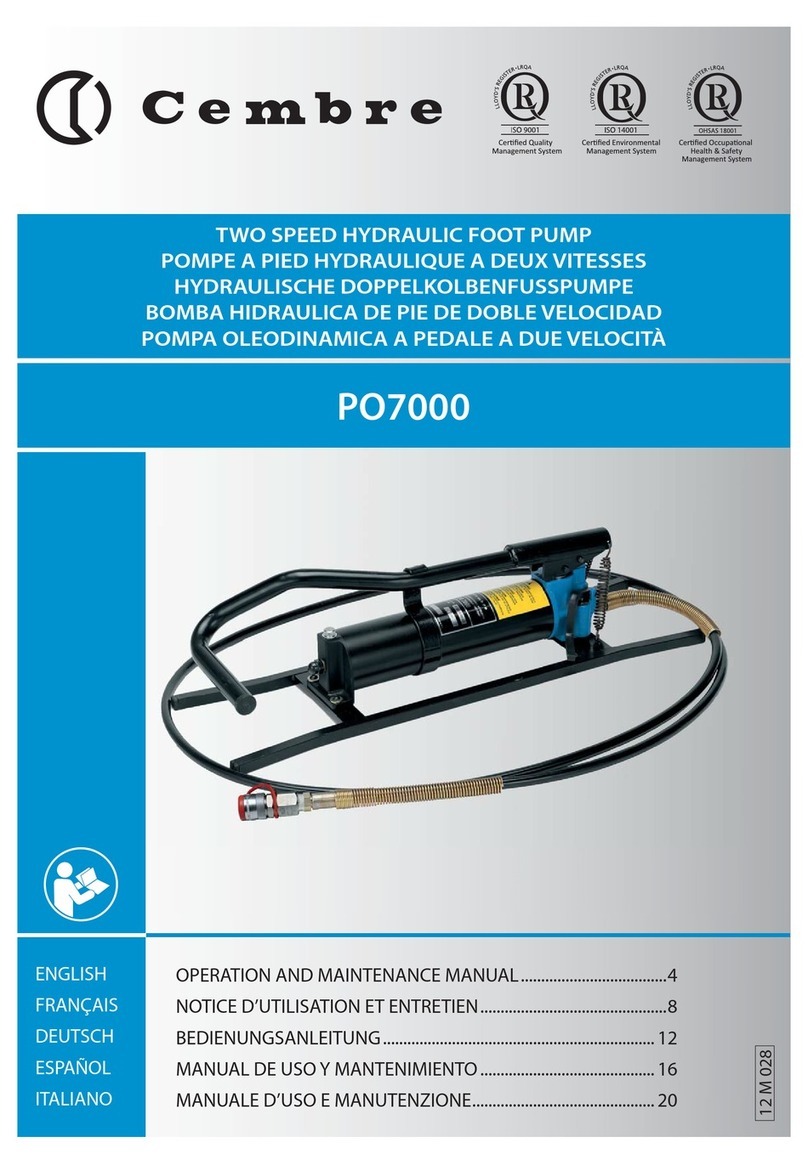
Cembre
Cembre PO7000 Operation and maintenance manual

GORMAN-RUPP PUMPS
GORMAN-RUPP PUMPS T3A61S-B Installation, operation and maintenance manual

Fresenius Kabi
Fresenius Kabi Amika Instructions for use
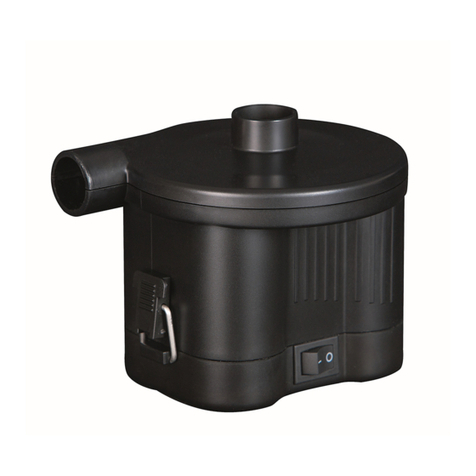
Bestway
Bestway 62038 operating instructions
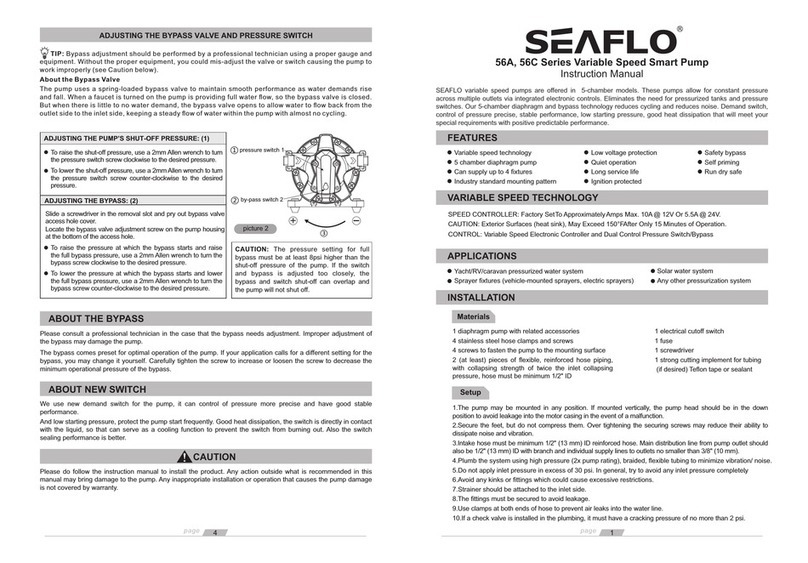
Seaflo
Seaflo 56A Series instruction manual
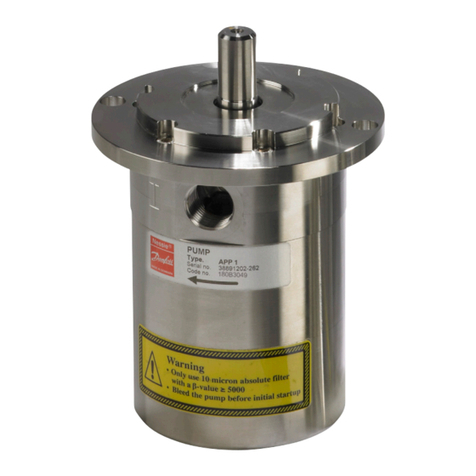
Danfoss
Danfoss APP 0.6 Service guide

